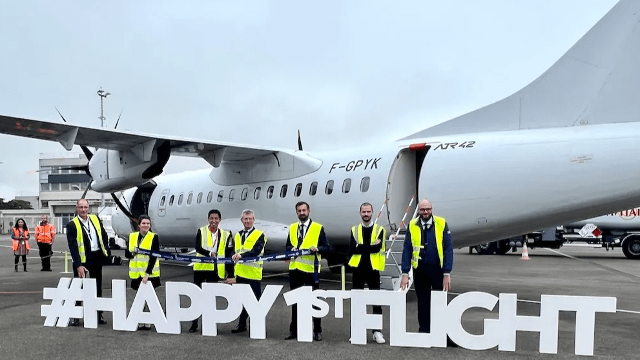The Union of French Airports (UAF), which is opposed to the abolition of domestic routes, has published a study showing the importance of cross-border routes in connecting French regions. Unsurprisingly, this study conducted by the firm Oxera also highlights the dominant role of low-cost airlines.
"Between 2010 and 2019, French domestic air traffic increased by 24%," notes Oxera. On cross-country routes, the number of passengers jumped by 72% but only increased by 5% on radial routes. Transversal routes connect regional airports to each other, while radial routes connect the regions to Paris. A significant part of the traffic between the regions and Paris is connecting traffic. "Transversal routes have thus increased from 29% of domestic traffic in 2010 to nearly 40% of it in 2019, with the share of radial routes therefore falling symmetrically from 71% to 60% over the same period."
Since 2010, a large number of cross-city routes have been created while the number of radial routes has remained relatively stable. The number of cross-city routes offered has increased from 111 to 168 in 2019, an increase of 51%. During the same period, the number of radial routes decreased slightly, from 39 to 37 in 2019 or a 5% decrease. "While the relative stagnation in the number of radial lines is not surprising (the number of region-Paris combinations being by nature limited), the significant increase in the number of cross-city lines is nonetheless noteworthy," the study's authors point out.
The spectacular increase in the number of radial routes between regional airports is due to the dynamism of low cost airlines. Their market share has continued to grow, reaching 37% of traffic in 2019 in metropolitan France. They represent more than half of the capacity offered (54%) on these routes in 2019.
easyJet in France more French than ever
"Since 2012, the three LCCs (Low Cost Carriers) that offer the most capacity on cross-border routes are easyJet, Volotea and Ryanair. Since 2011, easyJet has been the main low cost carrier active on cross-border routes in France. In addition, it can be noted that between 2010 and 2019 the difference in capacity offered between the first and second company has increased significantly (difference of 260,000 seats in 2010 against 2 million in 2019, or 8 times more)." The hierarchy between these three low-cost airlines can be explained by differences in business strategies.
"The average number of seats per aircraft increased by 49% between 2010 and 2019 for cross-border routes, while the increase was lower for radial routes, at 8% over the same period. However, these routes are still characterized by a higher average aircraft capacity than for cross-country routes (147 versus 117 seats per aircraft in 2019)."OXERA CABINET
For Oxera, "the dynamics of cross-border routes have mainly benefited the larger infrastructures in terms of capacity offered, but they have also strengthened the connections of smaller infrastructures (local airports) by increasing the number of routes. The growth in cross-city routes for the larger airports has therefore been driven primarily by an intensification of existing routes between them (and possibly by the creation of new routes)."
81.7% of the increase in capacity on cross-country routes between 2010 and 2019 is concentrated on routes between Large Regionals (more than 5 million passengers per year) and/or Regionals (airports with more than 1 mppa). The remaining 18.3% of growth corresponds to routes between "local" airports (less than 1 mppa) and larger airports.
Volotea, the Spanish low-cost airline that is half French
Through this study, the Union of French Airports is seeking to demonstrate the complementarity between rail and air travel. "On the 12 radial air routes with a rail alternative of less than 4 hours, the modal shift has already taken place," says Thomas Juin, UAF President. "On these routes, rail represents 85% of the traffic. On domestic cross-border routes, the Oxera study highlights the importance and growth dynamics of these routes and illustrates, in our view, the complementary nature of air and rail. On cross-border routes, air travel meets a need for rapid mobility among the French that rail transport cannot effectively satisfy given the configuration of the rail network. Cross-border routes are an opportunity to develop inter-regional exchanges and open up the regions.

Comments0
Please log in to see or add a comment
Suggested Articles


